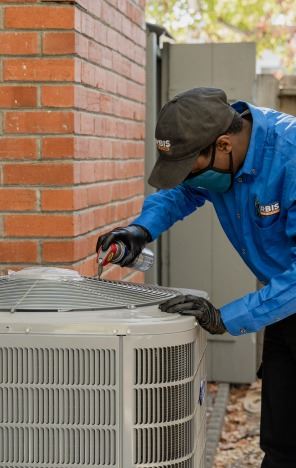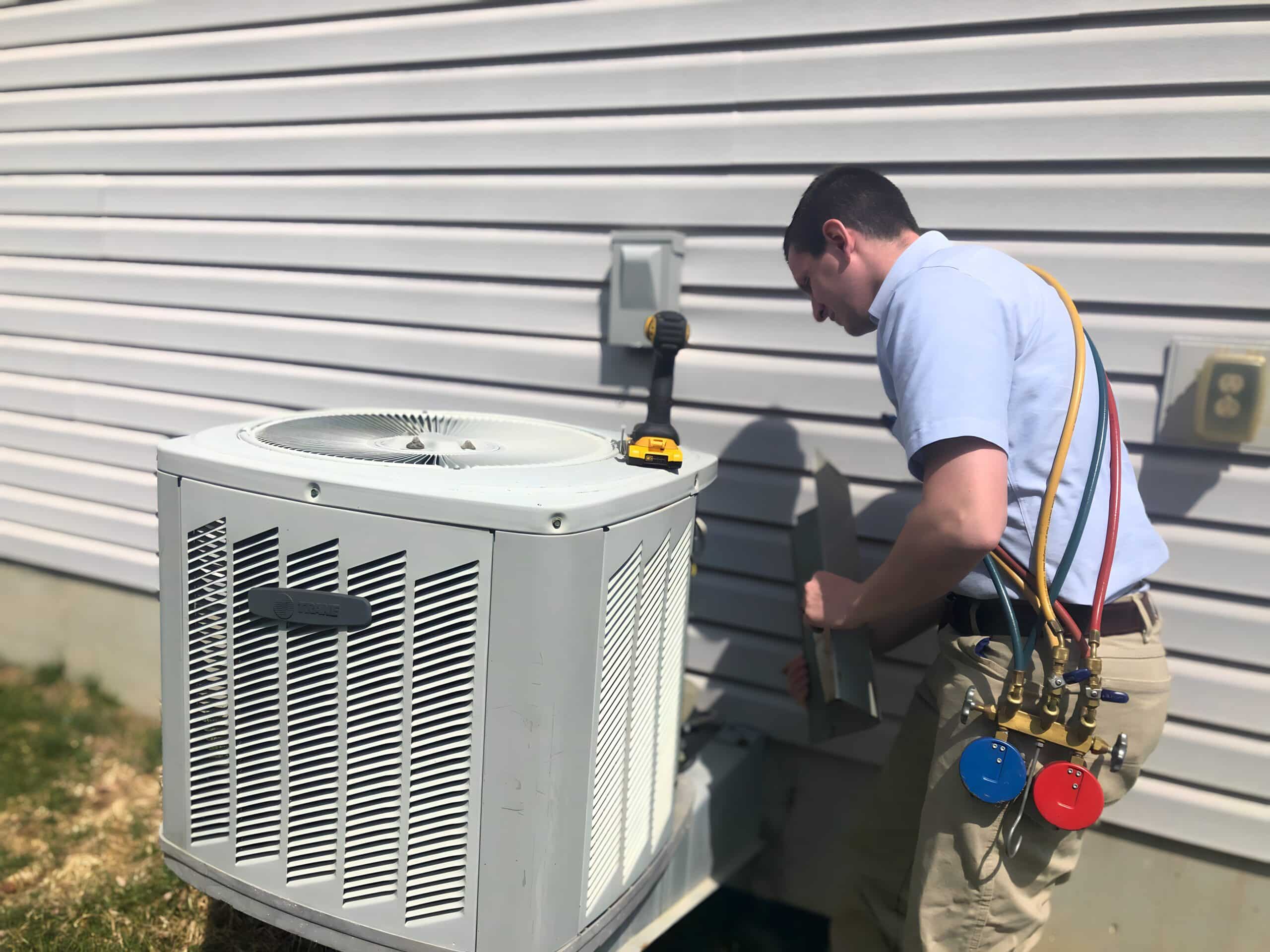Getting Started with heat pump installation ooltewah tn
Getting Started with heat pump installation ooltewah tn
Blog Article
Just How a Warm Pump and Furnace Interact to Optimize Your Home's Heating Effectiveness
Comprehending just how a heat pump and heating system interact is important for home owners seeking efficient home heating options. Each system has its toughness, supplying a balanced technique to home convenience. The heatpump excels in modest temperature levels, while the furnace supplies fast warmth throughout severe cold. This synergy not just decreases power expenses but also enhances the life-span of both appliances. What aspects influence this partnership, and exactly how can homeowners maximize their advantages?
Comprehending Warmth Pumps: How They Function
Although many individuals might be unknown with their internal workings, heat pumps play a necessary role in contemporary heating unit. These gadgets run by moving warm from one area to another, using the concepts of thermodynamics. In cooler months, a heat pump removes warmth from the outdoors air, ground, or water, and transfers it inside your home to heat the home. Alternatively, throughout warmer months, it can turn around the process, functioning as an air conditioning system by getting rid of warm from inside to the outside.Heat pumps contain an evaporator, condenser, expansion, and compressor valve. The refrigerant within the system absorbs warmth as it vaporizes at low temperature levels and pressures. The compressor after that enhances the stress and temperature of the cooling agent, enabling it to launch warm as it condenses. This effective process can substantially decrease energy intake compared to standard home heating techniques, making heat pumps a sustainable option for climate control in homes.
The Role of Heaters in Home Heating
Furnaces play an essential function in home heating by supplying a reliable resource of heat throughout the cooler months. They operate by producing warm via combustion or electrical resistance, dispersing it throughout the home via ducts or radiant systems. The effectiveness of a furnace is often determined by its Annual Gas Utilization Efficiency (AFUE) ranking, which suggests exactly how successfully the device converts fuel into heat.Furnaces can make use of numerous power resources, including natural gas, oil, propane, or power, allowing house owners to pick the most ideal option for their demands. Unlike heatpump, which may struggle in severe cool, heaters maintain consistent performance, making sure that interior temperatures stay comfortable despite outside conditions. In addition, modern-day heaters usually come geared up with advanced technology, such as variable-speed blowers and wise thermostats, boosting their performance and responsiveness. This versatility makes heaters a crucial component in all-encompassing home heating methods.

Benefits of Making Use Of Both Systems Together
Integrating the staminas of both heaters and heatpump can bring about a more reliable and efficient home heating solution. Using both systems enables property owners to capitalize on the heatpump's energy performance throughout milder temperature levels while depending on the heater for more extreme cold problems. This twin method can considerably minimize power costs, as heat pumps consume much less electrical power than traditional home heating approaches when temperatures are moderate.Additionally, utilizing both systems with each other can enhance convenience levels in the home. Heatpump can give consistent, also heating, while heaters can quickly elevate ambient temperatures when needed. In addition, the combination of both systems can expand the life expectancy of tools by decreasing damage on each device, as they share the work. Ultimately, property owners can take pleasure in a balanced, cost-efficient home heating solution that changes perfectly to differing weather conditions, guaranteeing a warm and inviting home throughout the winter season months.
How Warm Pumps and Furnaces Enhance Each Other
They produce a corresponding heating system that maximizes effectiveness and convenience when property owners integrate warm pumps and furnaces. Heat pumps run by transferring warm from the outside air or ground, making them extremely effective in moderate environments. They stand out during milder temperatures, giving cost-efficient heating. Conversely, heaters generate heat with burning or electric resistance, supplying solid, prompt heat during severe cool conditions.The mix of these two systems enables dynamic changes based upon temperature fluctuations. During warmer months or milder winter days, the heatpump can take the lead, preserving power and decreasing costs. As temperature levels decline, the heating system can flawlessly engage, guaranteeing regular heat throughout the home. This harmony not just optimizes power usage yet also boosts the life-span of both systems, as each device operates within its perfect efficiency array. With each other, they develop a well balanced environment that adjusts to differing climate demands.
Maximizing Efficiency: Tips for Homeowners
House owners can enhance their home heating performance through numerous sensible methods. Developing a normal upkeep timetable, integrating smart thermostat innovation, and implementing reliable insulation and sealing services are essential steps. These procedures not just enhance convenience but additionally reduce energy prices.
Regular Maintenance Schedule
To guarantee optimal home heating efficiency, developing a regular maintenance timetable is vital for any kind of home. Property owners must focus on routine assessments of both warmth pumps and heating systems to determine peak performance. This consists of changing air filters every one to three months, as stopped up filters can greatly decrease performance. Furthermore, organizing expert maintenance at the very least yearly allows technicians to identify and attend to potential concerns before they escalate. Property owners ought to likewise clean the heatpump's outdoor device to avoid particles buildup that can hinder airflow. By adhering to a routine upkeep timetable, property owners not just improve their heating unit' performance yet likewise expand their life expectancy, causing greater convenience and reduced energy expenses throughout the cooler months.
Smart Thermostat Assimilation
Integrating a wise thermostat into a home furnace can greatly improve energy effectiveness, specifically as it permits precise control over temperature level settings. These devices can find out the property owner's timetable and preferences, immediately changing the temperature to optimize convenience while decreasing energy use. For example, they can decrease heating throughout times when the home is vacant, decreasing unneeded intake. Lots of wise thermostats also supply real-time power use data, enabling homeowners to make enlightened choices about their home heating habits. Additionally, remote access by means of smartphone applications enables individuals to readjust settings from anywhere, making sure the home is warm upon return. On the whole, clever thermostat assimilation not just enhances convenience yet substantially More Bonuses contributes to power cost savings and efficiency.
Insulation and Sealing Solutions
Smart thermostats play a vital role in energy effectiveness, however their effectiveness can be greatly boosted by correct insulation and securing services. House owners ought to focus on insulating attics, wall surfaces, and floors to minimize heat loss. Top notch insulation products, such as spray foam or fiberglass, can greatly boost thermal resistance. Additionally, securing voids around doors, air ducts, and windows prevents cool air seepage and warm getaway. Weatherstripping and caulking are reliable methods for addressing these leaks - ductless mini splits. Routine evaluations for air leakages, together with making use of blower door tests, can aid recognize trouble locations. By spending in insulation and sealing, house owners can maximize the efficiency of their heating unit, ultimately resulting in minimized energy consumption and reduced utility expenses
Typical Myths Concerning Warmth Pumps and Furnaces
What false impressions surround warmth pumps and heaters? Many people incorrectly believe that heatpump are ineffective in colder climates. In fact, modern-day heat pumps are made to run effectively also in low temperature levels, giving trustworthy heating throughout winter season. An additional common misconception is that heaters are always more reliable than warm pumps. Nonetheless, this depends upon the details energy sources and performance ratings of the devices in concern. Some might also think that making use of both systems concurrently is unnecessary, however in reality, this combination can optimize heating effectiveness, particularly throughout severe climate condition. In addition, people commonly assume that warmth pumps need constant upkeep, when truthfully, they have comparable maintenance requires to conventional furnace. By unmasking these myths, house owners can make even more educated choices concerning their heating choices, eventually leading to boosted comfort and power effectiveness in their homes.
Maintenance Factors To Consider for Combined Solutions

Frequently Asked Concerns
Can Warmth Pumps Work Properly in Exceptionally Cold Climates?
Heat pumps can have a hard time in incredibly chilly environments because of reduced performance and warmth removal limitations. Improvements in technology have led to designs developed for better performance in such conditions, enhancing their feasibility in harsh environments.
The Length Of Time Do Warmth Pumps and Furnaces Typically Last?
Warmth pumps usually last 15 to 20 years, while heaters have a life expectancy of 15 to thirty years. Routine maintenance can extend their longevity, making sure efficient operation and minimizing the need for early replacements.

What Is the Average Price of Setting Up Both Solutions?
The average price of installing both a warmth pump and a heater usually varies between $5,000 to $10,000 - heat pump installation ooltewah tn. Variables influencing this cost consist of system dimension, setup intricacy, and local labor prices
Exist Tax Obligation Motivations for Making Use Of Energy-Efficient Home Heating Solutions?
Several property owners make inquiries about tax obligation motivations for energy-efficient home heating systems. Different federal and state programs commonly use credit ratings or rebates, motivating the adoption of sustainable technologies to minimize energy usage and promote ecological duty.
Just how Do I Choose the Right Dimension Warmth Pump and Furnace?
Selecting the appropriate size heat pump and heater entails calculating the home's square footage, taking into consideration insulation top quality, and reviewing neighborhood environment. Consulting a professional can assure ideal system performance and energy performance based upon details requirements. heat pump installation ooltewah tn. Understanding just how a heat pump and heating system work with each other is essential for home owners looking see here now for efficient home heating solutions. In chillier months, a warmth pump essences heat from the outdoors air, ground, or water, and transfers it inside your home to heat the living space. When property owners integrate warm pumps and heating systems, they produce a corresponding home heating system that takes full advantage of performance and he said comfort. Warm pumps operate by transferring warm from the outdoors air or ground, making them highly effective in modest environments. Heat pumps can struggle in incredibly chilly climates due to minimized efficiency and warmth extraction restrictions
Report this page